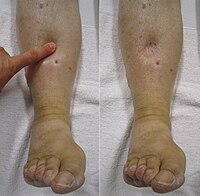
Photo from wikipedia
OBJECTIVE This prospective study aimed to investigate the evolution of chewing efficiency, maximum voluntary bite force (MBF) and oral health-related quality of life (OHRQoL) in edentulous patients treated with narrow… Click to show full abstract
OBJECTIVE This prospective study aimed to investigate the evolution of chewing efficiency, maximum voluntary bite force (MBF) and oral health-related quality of life (OHRQoL) in edentulous patients treated with narrow diameter implants (NDIs) over the course of 1 year. MATERIALS AND METHODS Four NDIs (MDI® , 3M ESPE, diameter 1.8 mm) were placed interforaminally in 20 edentulous patients. They were immediately loaded by converting the existing prosthesis into an implant overdenture. Participants were examined six times pre- and postoperatively [baseline (BL) to week 52 (w52)]. Chewing efficiency was evaluated with a colour-mixing ability test by evaluation of the standard deviation of hue (VOH, ViewGum©). MBF was measured using a digital force gauge. OHRQoL was determined with the Oral Health Impact Profile (OHIPG49). Nonparametric Brunner-Langer models were applied for statistical testing. RESULTS The study failed to demonstrate an effect on chewing efficiency. MBF increased continuously during the observation period (medians: MBF[N]@BL = 46.6 [iqr 50.1]; MBF[N]@w52 = 103.9 [iqr 76.0]; P = 0.002). OHRQoL increased steeply after implant loading and continued improving (medians: BL ∑OHIPG49 = 31 [iqr 40.0]; w4 ∑OHIPG49 = 11.5 [iqr 19.5]; w52 ∑OHIPG49 = 6 [iqr 13.0], P < 0.001). CONCLUSIONS The stabilisation of a lower complete prosthesis with four NDIs is a feasible minimally invasive and economical approach to improve oral function and OHRQoL, especially in elderly patients with limited bone support. Functional benefits might be more evident if patients receive chewing instructions. Larger studies need to confirm a positive effect on chewing efficiency and develop long-term maintenance solutions if patients become frail because no easy downgrading approaches of one-piece titanium implants exist.
Journal Title: Clinical Oral Implants Research
Year Published: 2017
Link to full text (if available)
Share on Social Media: Sign Up to like & get
recommendations!